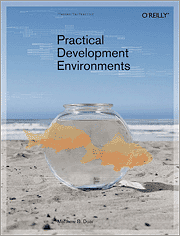|

|
"A good technical environment for developing your software can make or break a project, or even a company."
What a great opening hook from the preface of a book aimed at toolsmiths (those responsible for developing|selecting and maintaining tools which support the software development process). This book attempts to help the reader understand the problems these tools are supposed to address while offering a balanced assessment of some of today's more commonly used tools.
The scope of the development environment addressed by the book is stated in terms of specific software project lifecycle activities, namely; implementation, testing, documentation, release and maintenance.
For each of these project activities, the author presents a clear and objective summary of the featureset of the predominant tools available. Typically, a brief history of each tool is offered, which I found offered a helpful, FAQ-esque amount of background.
Each tool profiled also includes cost and licensing details. However, this book offers more than a who's-who of development tools. Through the use of checklists at the end of each chapter, the author challenges the reader to reflect on their requirements in the area just covered and to assess their existing solutions.
The real-world nature of the questions raised clearly reflect the experience of the author, which I found helped draw me in and believe this was a book written by a toolsmith for toolsmiths.
In a discussion of project concepts, the author hammers home the benefits of automation and how environment implies integration. While highlighting the clear problem of "what happens next when one component is unavailable", he cites the web and email as the easiest candidates for environment glue. However, he surrenders to the fact that "robust and tightly coupled integration schemes" for development tools in general is beyond the scope of this book, noting also that such super glue is outwith the scope of the problem domain tackled by the book - ie. software projects with less than 1 million lines of code and under 200 people.
Throughout, there are plenty of examples of problems, such as the horrors which can arise in poor build systems. Fore warned is fore armed, and these 'heads up' sections will serve the reader well, be it as an eye opener or a reminder.
However, the examples aren't all gloomy. I enjoyed the section where the author shared which tools were used for writing the book and how they interacted with the tools used by O'Reilly to publish all of their titles.
Besides tools' pros and cons, there is also guidance on tool migration and various human factors, such as; colour blindness and UI design, communication, dealing with awkward people and how to deal with the politics of commit rights.
Summary
I would say this is an ideal book for the objective overview of tools used in software development environments, offering readers a fantastic companion for evaluating or constructing practical development environements.
Table of contents
Practical Development Environments Ch 1. Introduction Ch 2. Project Basics Ch 3. Project Concepts Ch 4. Software Configuration Management Ch 5. Building Software Ch 6. Testing Software Ch 7. Tracking Bugs Ch 8. Documentation Environments Ch 9. Releasing Products Ch 10. Maintenance Ch 11. Project Communications Ch 12. Politics and People App A. How Tools Scale App B. Resources Index
